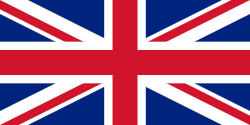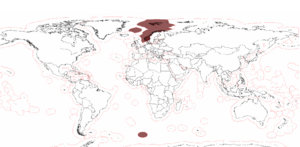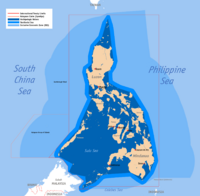Exclusive Economic Zone

Under the law of the sea, an Exclusive Economic Zone (EEZ) is a seazone over which a state has special rights over the exploration and use of marine resources.
Contents |
Definition

Generally a state's EEZ extends to a distance of 200 nautical miles (370 km) out from its coast. The exception to this rule occurs when EEZs would overlap; that is, state coastal baselines are less than 400 nautical miles apart. When an overlap occurs, it is up to the states to delineate the actual boundary.[1] Generally, any point within an overlapping area defaults to the most proximate state.[2]
The Exclusive Economic Zone starts at the coastal baseline and extends 200 nautical miles out into the sea, perpendicular to the baseline. Thus, the EEZ overlaps both the contiguous zone and territorial waters.[3] States also have rights to the seabed of the continental shelf up to 350 nautical miles from the coast, where this extends beyond the EEZ, but this does not form part of their EEZ.
Origin of EEZ
This concept of allotting nations EEZs to give better control of maritime affairs outside territorial limits gained acceptance in the late 20th century and was given binding international recognition by the Third United Nations Convention on the Law of the Sea in 1982.
Part V, Article 55 of the Convention states:
-
- Specific legal regime of the Exclusive Economic Zone
- The Exclusive Economic Zone is an area beyond and adjacent to the territorial sea, subject to the specific legal regime established in this Part, under which the rights and jurisdiction of the coastal State and the rights and freedoms of other States are governed by the relevant provisions of this Convention.
Fisheries management is a significant aspect of the resulting control.
EEZ disputes
Disputes over the exact extent of Exclusive Economic Zones are a common source of conflict between states over marine waters.
- One well-known example of such a dispute was the Cod Wars between the United Kingdom and Iceland.
- The dispute over Rockall is mainly due to its effect on EEZ, not on its resources or strategic benefits.
- The South China Sea (and the Spratly Islands) is the site of an ongoing dispute between several neighboring nations.
- There is an ongoing dispute over defining continental shelf and EEZ between Turkey and Greece.
- Conflict of Croatia with Italy and Slovenia over Croatian ZERP in Adriatic sea.
Regions where a permanent ice shelf extends beyond the coastline are also sources of potential dispute.[4]
Rankings by area
|
|
|||||||||||||||||||||||||||||||||||||||||||||||||||||||||||||||||||||||||||
By country
Argentina
1,159,063 km²
Australia

- Seas and Submerged Lands Act 1973
Australia has the third largest Exclusive Economic Zone, behind the United States and France, but ahead of Russia, with the total area actually exceeding that of its land territory. As per UN convention, Australia's EEZ generally extends 200 nautical miles (370 km) from the coastline of Australia and its external territories, except where a maritime delimitation agreement exists with another state.[5] The United Nations Commission on the Limits of the Continental Shelf confirmed, in April 2008, an additional 2.5 million square kilometres in seabed to Australia's EEZ[6]. Australia also claimed, in its submission to the UN Commission on the Limits of the Continental Shelf, an EEZ of 200 nautical miles (370 km) from its Antarctic Territory but has requested it not be considered, in accordance with the Antarctic Treaty.[7] Nevertheless, Australia maintains the right to explore and exploit the seabed and water column within its EEZ.
| EEZ | Area (km²) [8] |
|---|---|
| Heard and McDonald Islands | 410,722 |
| 463,371 | |
| 325,021 | |
| 428,618 | |
| Macquarie Island | 471,837 |
| Recent United Nations Approvals | 2,500,000 |
| 6,048,681 | |
| TOTAL | 10,648,250 |
Brazil
- Continental shelf: 3,191,827 km²
- Trindade and Martim Vaz Island: 469,128 km²
- total: 3,660,955 km²
Canada
Canada is unusual in that its Exclusive Economic Zone, covering 2,755,564 km², is slightly smaller than its territorial waters.[9] The latter generally extend only 12 nautical miles from the shore, but also include inland marine waters such as Hudson Bay (about 300 nautical miles across), the Gulf of Saint Lawrence and the internal waters of the Arctic archipelago.
European Union
The EEZ of the European Union is shared, so vessels or a national from one country can fish in another country's EEZ.[10] The combined zone amounts to 25 million km², making it larger than the United States' zone, the largest of any single country.[11] '"See: Common Fisheries Policy.
France

Due to its numerous overseas départements and territories scattered on all oceans of the planet, France possesses the second-largest EEZ in the world, covering 11,035,000 km² (4,260,000 mi²), just behind the EEZ of the United States (11,351,000 km² / 4,383,000 mi²), but ahead of the EEZ of Australia (10,648,250 km² / 4,111,312 mi²). According to a different calculation cited by the Pew Research Center, the EEZ of France would be 10,084,201 km² (3,893,532 mi²), behind the United States (12,174,629 km² / 4,700,651 mi²) and Australia (10,648,250 km² / 4,111,312 mi²), but ahead of Russia (7,566,673 km² / 2,921,508 mi²).
The EEZ of France covers approximately 8% of the total surface of all the EEZs of the world, whereas the land area of the French Republic is only 0.45% of the total land area of the Earth.
Greece
Greece has not yet claimed an exclusive economic zone, although it is entitled to do so, as per UNCLOS 1982 as well as customary international law. The reason for its inaction is the direct Turkish threat of casus belli.
Turkey's declaration of casus belli is not related to the EEZ issue. Turkey claims that the Aegean Sea's status as a semi-closed sea affords it a special nature (unlike other semi-closed seas as the Adriatic or even fully enclosed seas as the Black Sea). Moreover, Turkey is not among the signatories of UNCLOS which allows countries to expand the width of their territorial waters up to 12 nautical miles. Even though Turkey is a persistent objector to the relevant article of UNCLOS, it has expanded its own territorial waters in the Black Sea to 12 nautical miles. In 1995, just after Greece's ratification of UNCLOS, Turkey declared that if Greece expands the width of her territorial waters over 6 nautical miles, Turkey would conceive this action as a containment attempt and a direct offence to her sovereignty. So, the Turkish Parliament decided that if Greece attempts to expand the width of her territorial waters it would be a cause of war (casus belli).
Portugal

Portugal has the 3rd largest Exclusive Economic Zone of the EU and the 11th in the world.
A dispute with Spain arose after a number of incidents. Spain defends that the southernmost EEZ border between Spain and Portugal should consist on an equidistant line drawn halfway between Madeira and the Canary Islands. But Portugal exercises sovereignty over the Savage Islands (a small archipelago north of the Canaries) thus pushing the EEZ border further south.
Spain objects on the basis that the Savage Islands do not have a separate continental shelf[12], according to the article 121 of the United Nations Convention on the Law of the Sea:
"Rocks which cannot sustain human habitation or economic life of their own shall have no exclusive economic zone or continental shelf."[13]
However, the Savage Islands do sustain human habitation, annulling the Spanish argument.
United Kingdom

Note: the British Overseas Territories and the Crown Dependencies are not part of the United Kingdom.[14]
 United Kingdom: 764,071 km²
United Kingdom: 764,071 km² Ascension Island (UK): 443,844 km²
Ascension Island (UK): 443,844 km² British Indian Ocean Territory (UK): 636,600 km²
British Indian Ocean Territory (UK): 636,600 km² Channel Islands (UK): 6,517 km²
Channel Islands (UK): 6,517 km² Gibraltar (UK): 331 km²
Gibraltar (UK): 331 km² Montserrat (UK): 8,247 km²
Montserrat (UK): 8,247 km² Pitcairn (UK): 837,221 km²
Pitcairn (UK): 837,221 km² Saint Helena (UK): 446,616 km²
Saint Helena (UK): 446,616 km² Tristan da Cunha (UK): 749,612 km²
Tristan da Cunha (UK): 749,612 km² British Virgin Islands (UK): 80,701 km²
British Virgin Islands (UK): 80,701 km²- total: 3,973,760 km²
South Africa

South Africa's EEZ includes both that next to the African mainland and that around the Prince Edward Islands, totalling 1 535 538 km². [15]
- Mainland 1 068 659 km²
- Prince Edward islands 466 879 km²
India
- 1,641,514 km²
- Andaman Islands, 663,629 km²
- Total: 2,305,143 km²
Japan

- Marcus Island: 428,875 km²
- Ogasawara Islands: 862,782 km²
- Pacific Ocean (Japan): 1,162,334 km²
- Ryukyu Islands: 1,394,676 km²
- Sea of Japan: 630,721 km²
- total: 4,479,358
Japan has disputes over its EEZ boundaries with all its Asian neighbours (Russia, South Korea, PRC and ROC). The above and relevant maps at the Sea Around Us Project[16][17] both indicates Japan's claimed boundaries, and does not take into account neighbouring power's claims.
South Korea
Area: 300,851 (225,214) km²
New Zealand

New Zealand's EEZ covers 4,083,744 km², according to the Sea Around Us Project,[18][19] which is approximately fifteen times the land area of the country. Sources vary significantly on the size of New Zealand's EEZ; for example, a recent government publication gave the area as roughly 4,300,000 km².[20] These figures are for the EEZ of New Zealand proper, and do not include the EEZs of other territories in the Realm of New Zealand (Tokelau, Niue, the Cook Islands and the Ross Dependency).
Norway

Norway has a large exclusive economic zone of 819 620 km² around its coast. The country has a fishing zone of 1,878,953 km², including fishing zones around Svalbard and Jan Mayen [21]. The fact that the European Union shares its economic zones was a big reason why Norway did not enter the EU as a member.
Pakistan
- 201,520 km² [22]
Philippines

Philippines' EEZ covers 1,590,780 (272,921) km² according to this website.
Russia
- Asia: 6,382,530
- Baltic: 24,549
- Barents Sea: 1,159,594
- total 7,566,673 km²
United States

information needed
Largest EEZ in the world: 11,351,000 km² / 4,383,000 mi²
- Magnuson-Stevens Fisheries Conservation and Management Act of 1976
References
- ↑ William R. Slomanson, 2006. Fundamental Perspectives on International Law, 5th edn. Belmont, CA: Thomson-Wadsworth, 294.
- ↑ UN Convention on the Law of The Sea.
- ↑ William R. Slomanson, 2006. Fundamental Perspectives on International Law, 5th edn. Belmont, CA: Thomson-Wadsworth, 294.
- ↑ The Legal Status of Ice in the Antarctic Region
- ↑ Geoscience Australia. 2005. Maritime Boundary Definitions.
- ↑ Minister for Resources and Energy, The Hon Martin Ferguson AM MP, Media Release, 21 Apr 2008. [1]
- ↑ Division for Ocean Affairs and the Law of the Sea. Commission on the Limits of the Continental Shelf, Submission by Australia
- ↑ Geoscience Australia, Australian Maritime Boundaries Information System 2001. Area of the Australian Exclusive Economic Zone
- ↑ Wildlife Habitat Canada. Canada's Marine Waters: Integrating the Boundaries of Politics and Nature.
- ↑ About the Common Fisheries Policy
- ↑ EU Glossary europa.eu
- ↑ Lacleta Muñoz, José Manuel: "Las fronteras de España en el mar". Documentos de trabajo 34-2004, Real Instituto Elcano
- ↑ United Nations Convention on the Law of the Sea, Part VIII, Article 121
- ↑ "Countries within a country". Retrieved on 2008-05-12.
- ↑ Sea around us project
- ↑ Japan (main islands) The Sea Around Us Project
- ↑ Japan (outer islands) The Sea Around Us Project
- ↑ New Zealand Sea Around Us Project
- ↑ Kermadec Islands (New Zealand) The Sea Around Us Project
- ↑ New Zealand Ministry for the Environment (2007). Improving Regulation of Environmental Effects in New Zealand’s Exclusive Economic Zone: Discussion Paper - Introduction. Published August 2007, Publication number ME824. ISBN 0978478301601. Accessed 2006-01-07.
- ↑ Statistisk årbok 2007 Accessed January 2008
- ↑ Coastal and Marine Ecosystems — Marine Jurisdictions Accessed 1 November 2006
See also
- Baseline
- Territorial waters
- Continental shelf
- International waters
- Air Defense Identification Zone
External links
- United Nations Convention on the Law of the Sea - Part V
- Sea Around Us Project - View the EEZ of all nations (Note that this site does not distinguish between territorial waters and the EEZ, and so tends to overstate EEZ areas.)
- The USA zone since 1977
- GIS data : http://www.vliz.be/vmdcdata/marbound/
|
|||||||||||||||||||||||